The Falcon 9 rocket booster, which made its way to to the launch facilities, has also been flown twice already.
But instead of a docking module built into the nosecone of the Crew Dragon, the spacecraft will be outfitted with a massive glass dome that will give its occupants an incredible view of the Earth below.
It’s a momentous occasion for the space company. If successful, SpaceX could prove once and for all that spaceflight is indeed possible — even without decades of training.







